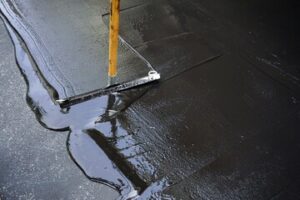Asphalt pavement is comprised of rock and gravel held together with a petroleum binder made from refined coal tar and specially formulated oils. Rain, UV rays and chemicals can degrade the asphalt binder over time, causing it to turn grey and brittle.

To prevent this, you should sealcoat your paved surfaces every two to three years. To do this, you’ll need the best asphalt Rochester NY Sealcoating equipment.
Asphalt is a very durable material, but it’s not immune to the aging process. The sun’s ultraviolet rays can cause oxidation of the asphalt surface and break down the chemicals that hold it together, creating a surface that becomes brittle and cracks easily. This is why it’s important to have regular seal coating services performed on your asphalt parking lot or driveway.
The process of asphalt seal coating involves spraying a liquid layer of protection on the surface. The emulsion is made of silica sand, oil, polymer additives, water, and other materials that help to prevent the degradation of your asphalt surface. Workers spread the emulsion using spray hoses, brushes, and hand squeegees to ensure that it fills in all of the cracks and gaps on the surface of your asphalt.
The seal coat will restore the deep black appearance of your asphalt and form a protective barrier against rain, UV rays, oil, and other chemicals. It also adds traction to the surface of your asphalt and reduces slippage, which is particularly helpful when your parking lot or driveway is wet. By reducing the risk of accidents, you can save money by preventing the need for costly repairs or replacements. The regular application of seal coating will extend the life of your asphalt surface and keep it looking beautiful for years to come.
Prevents Water Damage
Asphalt surfaces are vulnerable to water damage. Untreated pavement can absorb water that seeps into surface cracks and then freezes during the winter, causing larger cracks and more severe damage. Sealcoating prevents this by filling in any small surface cracks to create a barrier that stops water from entering the pavement.
Another way that sealcoating prevents water damage is by preventing the penetration of harmful substances into asphalt. Oil, fuel, and chemical spills can deteriorate asphalt over time and cause further damage. Sealcoating protects the underlying pavement from these materials and keeps it strong against the abrasive action of vehicular traffic.
Leaks are another major problem that can lead to premature pavement failure and require costly repairs. When automobile fluids such as gasoline, oil, and diesel fuel leak on asphalt they can essentially “join” with the binder and soften it. This process can also accelerate the deterioration of the asphalt. Sealcoating prevents this by creating a durable, protective layer that resists the penetration of automotive fluids into the asphalt.
One important thing to note is that if your asphalt parking lot contains any black oil spots these must be repaired before you get it sealcoated. Oil spots can bleed through the sealcoat and contaminate the asphalt beneath, which will prevent it from absorbing and protecting it like it should. Also, any manhole covers or utility access points should be protected from the sealcoat material.
Prevents Oil Spills
Asphalt is a petroleum product, and its structure is susceptible to damage from oil, gas and chemical spills. These spills contaminate the surface, making it harder to clean, and can penetrate the pavement, causing softening and weakening. Sealcoating creates a barrier that prevents these substances from seeping into the asphalt, keeping them on the outer surface where they are easier to remove.
When it comes to preventing asphalt damage, sealcoating is a cost-effective solution. Although it is an additional expense to your asphalt budget, its long-term benefits far outweigh the initial investment. In addition, professionally applied sealcoating is faster and safer than DIY applications. Professionals use high-quality materials and equipment, which reduce the time it takes to complete the project.
If you notice oil stains on your asphalt parking lot or driveway, it’s important to address them as soon as possible. Not only are they unsightly, but left unaddressed, they can penetrate the surface of the asphalt and cause irreparable damage. Sealcoating acts as a protective shield that keeps petroleum-based products from seeping into the asphalt, minimizing damage and allowing you to clean the area easily.
Aside from preventing the penetration of harmful chemicals, sealcoating also enhances the aesthetic of your asphalt. By restoring its jet-black appearance, sealcoating gives your business or home a more inviting appeal. In addition, properly applied sealcoating increases the lifespan of your asphalt, saving you money in the long run by avoiding costly repairs or replacement.
Prevents Chemical Spills
Sealcoating halts the degradation of asphalt pavements by shielding them from the elements that can cause premature wear and tear. UV rays, water infiltration and harmful chemical spills can cause asphalt to crack and deteriorate. Sealcoating fills in surface voids, significantly reducing the porosity and thwarting water-induced damage such as potholes and fissures. This preventative measure spares property owners the costly cycle of reactive maintenance that can lead to customer dissatisfaction and litigation from accidents caused by a poorly maintained parking lot.
The appearance of a commercial property plays a key role in its marketability. Parking lots that are routinely sealcoated look fresh and well-maintained, attracting a higher caliber of tenants and boosting the value of commercial properties.
As a bonus, the dark black color of the asphalt becomes more visible through the sealcoat and enhances the overall aesthetic of the property. In addition, the protective layer wards off oil drips and chemical spills, making it easier to clean up these stains and minimize their long-term damaging effects. This is a benefit for both commercial properties looking to attract customers and homeowners who want to maintain their property’s value. The investment in this proactive step translates into significant cost savings over the long run by extending the lifespan of asphalt surfaces and minimizing the need for costly repairs or replacements. The resulting increase in the property’s resale or rental value can make this a sound financial decision for any business owner.
Prevents Cracking
Sealcoating is a protective layer that can dramatically reduce the rate of cracking in asphalt. It is a preventative treatment that can help extend the lifespan of your pavement, minimizing the need for costly repairs and replacements.
The cracking of asphalt is often caused by a number of factors, including oil and chemical spills, UV rays, water penetration, and weather conditions. Regular sealcoating can protect your asphalt from most of these factors, slowing down the oxidization process and preventing water penetration.
A fresh coat of sealant helps fill small cracks and holes, giving your parking lot a new, smooth appearance that improves curb appeal and overall property value. It also makes it much easier to clean, especially for businesses that use their parking lot for messy work projects.
In addition, sealing prevents the evaporation of water from the pavement surface. This water seepage is a significant source of cracking in asphalt. Water infiltrates these cracks and erodes the subgrade that supports the asphalt. The resulting cracks are exacerbated by freeze/thaw cycles.
Before a sealcoat is applied, the pavement must be completely free of dirt, debris, and other materials that won’t adhere to the surface. A professional pavement contractor will use robust cleaning equipment to ensure the pavement is ready for a fresh coat of sealant. They will sweep and blow the area using specialized machines, making sure all linear cracks are blown out and filled with a hot rubberized crack filling compound to make them look uniform and finished.
Saves Money
Pavement sealcoating helps to strengthen the asphalt which decreases the need for repair and replacement. This saves on the initial cost of installation and also reduces repair fees over the years. Additionally, the sealing process helps to protect against the penetration of vehicle fluids which will break down the aggregate and asphalt causing cracks and potholes. Having the ability to withstand these chemicals will significantly prolong the life of your driveway or parking lot.
The initial costs of sealcoating are pennies per square foot versus repairs or replacement which can cost several dollars a square foot. This makes it an economical preventative maintenance strategy that will pay off in the long run.
Aside from the financial benefits, having a well-maintained pavement with a fresh black, clean appearance is good for business and the overall look of the property. It will send a positive message to customers and tenants that the property owners are dedicated to quality.
When you invest in a professional Sealcoating Company, they will do everything possible to make sure your parking lot or driveway looks its best before and after the job is completed. Before applying the sealant, they will prepare and clean the surface to remove any debris or existing problems like cracks. After the preparation and cleaning, they will apply the sealant with a spray or squeegee. When they are finished, the surface will dry for about 24 hours.


